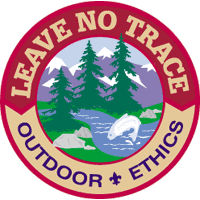
Durable Surfaces
Campsite Placement
Demonstrate the value of proper campsite placement.
Goal
Participants will evaluate an area and choose a proper location for the components on their campsite.
Time
20 minutes.
Objectives
Participants will be able to:
- identify durable and non-durable surfaces for campsites
- identify appropriate locations for campsites
- organize components of a campsite
Materials
- 1 copy of Durable Surfaces Worksheet #3 for each group
Motivator
A properly placed campsite provides for a nice camping experience as well as minimizing our impact. You can set up a tent pretty much any place, but spending a little effort finding a 'good' place makes a big difference.
Presentation
- Hand out Durable Surfaces Worksheet #3 to each group and have them cut out the small images of tents, fire, waterfilter, ... at the bottom.
- Explain that your group is taking a walk through the woods on a trail at the bottom of the worksheet when the woods open up to a beautiful meadow. You are about ready to stop for the day, so this will be where we camp for the night.
- Ask each group to survey the area and select an appropriate campsite.
- Then, have them place their tents, campfire, cooking area, latrine, and water source where they would go. You can define the size of their group as 1, 2, 3, or 4 tents.
Reflection
- Ask each group to show where they placed their campsite and give their reasoning.
- Discuss the location of:
- catholes - probably in the woods
- cooking area - hopefully away from tents and on most durable surface available
- campfire - who decided to have a campfire? why or why not? Are there any established fire spots already?
- water filter - either lake or creek, anyone use the rocky shore rather than grassy? How about where the trail crosses the creek?
- Were campsites 200 feet from trail and water?
- Were campsites close to, or in, forested portion to be more hidden from trail?
- How might the campsites be different if you choose to set up on the north or south sides of the meadow? (shade on the south side)
- If we were staying here one night, how many times would we need to get water? How could we minimize our impact when getting water? (different route each time, different spot to get water, fill all water containers in one trip)


